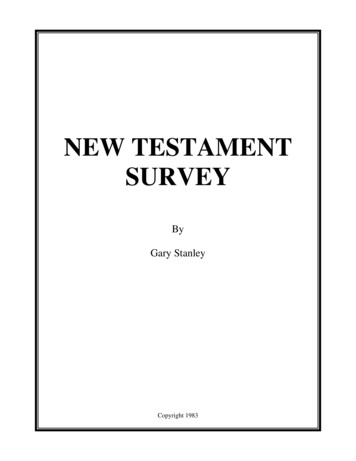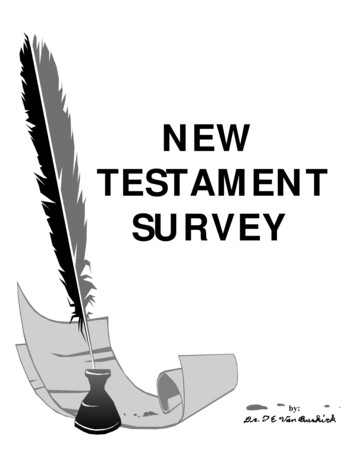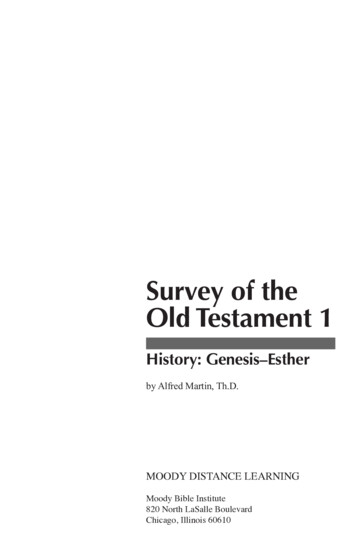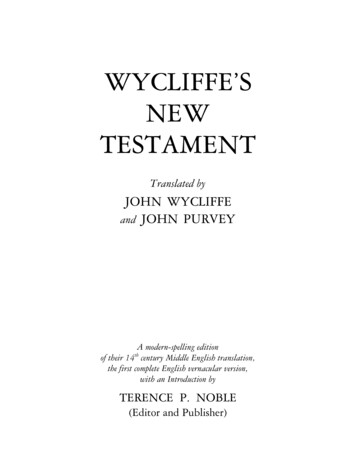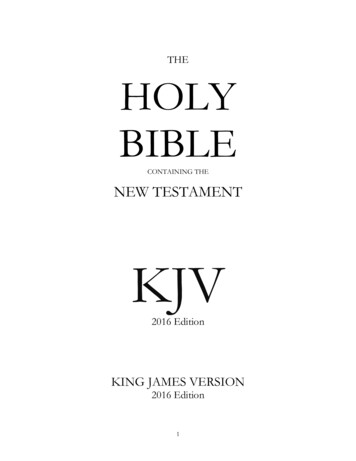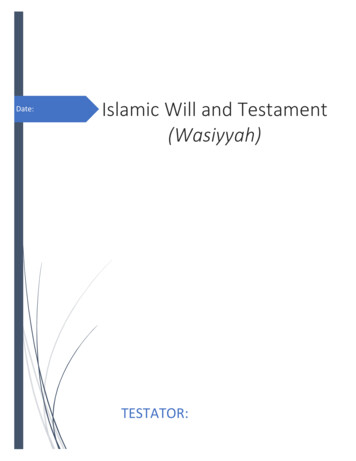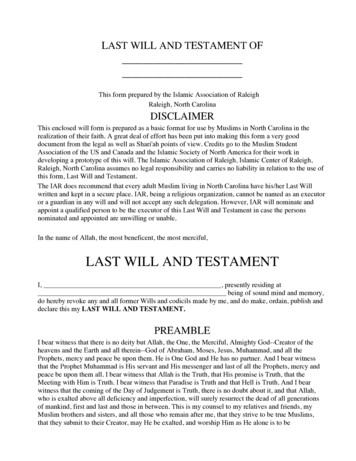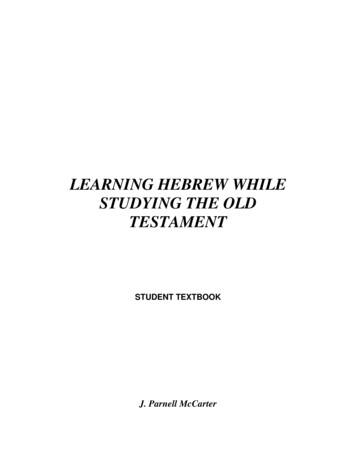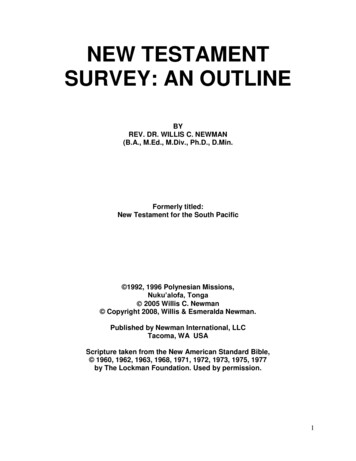
Transcription
NEW TESTAMENTSURVEY: AN OUTLINEBYREV. DR. WILLIS C. NEWMAN(B.A., M.Ed., M.Div., Ph.D., D.Min.Formerly titled:New Testament for the South Pacific 1992, 1996 Polynesian Missions,Nuku’alofa, Tonga 2005 Willis C. Newman Copyright 2008, Willis & Esmeralda Newman.Published by Newman International, LLCTacoma, WA USAScripture taken from the New American Standard Bible, 1960, 1962, 1963, 1968, 1971, 1972, 1973, 1975, 1977by The Lockman Foundation. Used by permission.1
INTRODUCTIONThe purpose of this brief work is to give you a basic overview of the New Testament. Includedin this birds-eye-view are general facts regarding the Bible as a whole and the New Testamentin particular. I also introduce some basic concepts about interpretation and canon.From there I go into areas of the historical and cultural context where the New Testament tookits form. It is important to anchor the words of the New Testament into the events, history,social structures, culture, and places of this world.I give a basic background and outline of each of the books of the New Testament. Included inthe background is the author of the book, the immediate intended audience, occasion of writing,and the date and place it was written. There is a selected list of over 90 excellent evangelicalresources at the end. The ebook is about 118 compact pages in all.An outline of the life of Christ is given, the ministry of the early disciples explored, and thehistory of early church expansion is unfolded.The text is written in outline form, as it consists of my New Testament lecture notes. It mayseem somewhat choppy, but it boils down the essential facts of the New Testament.2
Introduction .Table of contentsAbout the authorHow to be saved.TABLE OF CONTENTS.2356.8899101113PART ONE:INTRODUCTION AND CONTEXTOF THE NEW TESTAMENTI. INTRODUCTION AND CONTEXTA. The purpose of the BibleB. The name New TestamentC. General factsD. Christ the key to the BibleE. Factors used to prepare the world for ChristF. Outline of the New TestamentG. The world of the New Testament.Political, Hellenistic, religions, literature, Judaism, social, landPART TWO:ISSUES OF INTERPRETATION AND CANONII. ISSUES OF INTERPRETATION AND CANONA. Foundational concepts of God's message to manB. Assumptions of interpretation summarizedC. Concepts of verbal, plenary inspiration summarizedD. Concepts of canonicity summarizedE. Language of the NT.F. The NT Texts are reliableG. The Synoptic Problem .H. Form Criticism .3132333435353639PART THREE:THE APOSTOLIC PERIOD:JESUS TO JOHN (TO A.D. 100)III. THE APOSTOLIC PERIOD: JESUS TO JOHN (TO AD 100)A. The Life of Jesus Christ1. Jesus came in the fullness of time2. Christ presented as the pre - incarnate Word3. Jesus presented in birth and childhood4. Christ presented in ministryB. The ministry of the Apostles1. From Pentecost to the Apostle Paul2. From Paul's conversion to the Jerusalem council3. From the Jerusalem council to Nero's persecution4141414243444444453
4. From Nero's persecution to John's death5. The construction of the Christian church6. The worship of the apostolic church7. Methods of Christian evangelism8. Forms of heresy in the apostolic church9. The spread of the apostolic churchC. Status of the world at Christianity's inception48495050515152PART FOUR:THE NEW TESTAMENT BOOKS SUMMARIZEDIV. NEW TESTAMENT BOOKS SUMMARIZEDA. MatthewB. MarkC. LukeD. JohnE. ActsF. RomansG. 1, 2 CorinthiansH. Galatians, EphesiansI. Philippians, ColossiansK. 1 - 2 ThessaloniansL. 1 - 2 Timothy, TitusJ. PhilemonM. Hebrews, JamesN. 1, 2, 3, Peter; 1, 2, 3, John, JudeO. RevelationSELECTED BIBLIOGRAPHY.55616468727779, 8284, 8789, 9295, 9697, 99, 101102103, 105106-111113.1174
ABOUT THE AUTHORI was born and raised on a cattle ranch in central Idaho, USA. The closest village was about a30 minute drive, and its population was about 150 people. While working after spending a shorthitch in the Army, I went to work on road construction in central Oregon. That is where a pastorled me to Christ in 1965.I decided to try college, and eventually completed a bachelor’s degree (B.A.) in psychology,and master’s degree (M.Ed.) in counseling from the University of Portland. Finding somesuccess at higher education, I took a one year certificate course at Multnomah School of theBible, and finished up with a master of divinity (M.Div.) in pastoral studies at WesternConservative Baptist Seminary. From there I completed my Ph.D. in church administration atCalifornia Graduate School of Theology (1978), and a doctor of ministry (D.Min.) in crosscultural studies at Faith Evangelical Lutheran Seminary in Tacoma, Washington.God gave me time pastoral ministry for eight years, and from there I started teaching. First, Iserve as director of pastoral studies and taught Bible, counseling, and church history atInternational College and Graduate School of Theology in Honolulu, Hawaii.From there, I had the opportunity to establish a Bible school and Seminary in the Kingdom ofTonga, South Pacific. That project started in 1985. There I served for eight years as the SouthPacific director for Faith Evangelical Lutheran Seminary and Polynesian Missions. I kept myhand in teaching courses in theology, Bible, missions, apologetics, etc. I also was guestlecturer for International School of Theology – Asia (Campus Crusade in Manila).In1998 the Lord moved me back to the Pacific Northwest, USA where I still lecture for FaithEvangelical Seminary (they changed their name), and teach several courses in psychology andsociology at a local community college. I also picked up credentials for counseling. My Filipinawife of eight years, Esmie, is a graduate of Faith Evangelical Seminary, University of the East(Manila), and University of Washington. She is an accountant and office manager.We both tend to this website, and travel to Tonga and the Philippines to establish the work ofNewman International, LLC.The next page deals with how to become a Christian. The Apostle, John, wrote, “Many othersigns therefore Jesus also performed in the presence of the disciples, which are not written inthis book; but these have been written that you may believe that Jesus is the Christ, the Son ofGod; and that believing you may have life in His name” (John 20:30, 31).Consequently, it is good for me to deal with first things first, and make sure that I fulfill thepurpose of the New Testament in obedience to Jesus Christ.5
HOW TO BE SAVEDThe Bible gives us the message (gospel) of how to be saved. By this we mean how togain forgiveness for our sin and how to gain eternal life. Summarized below are thesteps for salvation as presented in the Bible. We invite you to receive Christ as Savior.AGREE1. Agree in your heart with God that you are a sinner in need of His salvation, “For allhave sinned and fall short of the glory of God” (Romans 3:23).KNOW2. Know in your heart that there is a penalty to your sin, “for the wages of sin is death”(Romans 6:23a).BELIEVE3. Believe in your heart that Christ died on the cross and rose from the dead to pay thepenalty for your sins and to give you eternal life, “But God demonstrates His own lovetoward us, in that while we were yet sinners, Christ died for us” (Romans 5:8).“Being justified as a gift by His grace through the redemption which is in Christ Jesus”(Romans 3:24).“For God so loved the world, that He gave His only begotten Son, that whoever believesin Him should not perish, but have eternal life” (John 3:16).“But the free gift of God is eternal life in Christ Jesus our Lord” (Romans 6:23).RECEIVE4. By faith pray to God. Tell Him you believe the above in your heart and ask Him tosave you through Jesus Christ. Remember that god is more concerned with the attitudeof your heart rather than your exact words.“For by grace you have been saved through faith; and that not of yourselves, it is the giftof God; not as a result of works, that no one would boast” (Ephesians 2:8, 9).“If you confess with your mouth Jesus as Lord, and believe in your heart that God raisedHim from the dead, you shall be saved; for with the heart man believes, resulting inrighteousness, and with the mouth he confesses resulting in salvation” (Romans 10:9,10).6
“Behold, I (Jesus) stand at the door (of your heart) and knock; if anyone hears My voiceand opens the door, I will come in to him, and will dine with him, and he with Me”(Revelation 3:20).“But as many as received Him (Jesus), to them He gave the right to become children ofGod, even to those who believe in His name, who were born not of blood, nor of the willof the flesh, nor of the will of man, but of God” (John 1:12, 13).ASKThe following is a suggested prayer:Heavenly Father, I admit to you that I am a sinner in need of your salvation. I believethat Christ died on the cross and rose from the dead to pay for my sins and go give meeternal life. I believe that only through Christ can I be saved. I ask for and accept byfaith your free gift of salvation. Please come into my heart and be my Savior and Lord.Thank you for doing so. In Jesus’ name, amen.7
SURVEY OF THE NEW TESTAMENT:AN OUTLINEPART ONE:INTRODUCTION AND CONTEXTOF THE NEW TESTAMENTI. INTRODUCTION AND CONTEXT.A. THE PURPOSE OF THE BIBLE.The purpose of the Bible is to bear witness of one God who is the Creator andSustainer of the entire universe. This witness is through Jesus Christ, the Messiah of the OldTestament, the Redeemer of sinful mankind. The story of the Bible is a progressive unfolding ofone central theme: the provision of redemption for sinful, fallen mankind through the person ofJesus Christ of Nazareth, who is the incarnate God of the universe. The Old Testament tells ofthe preparation for Christ; the New Testament tells of the manifestation and explanation ofChrist.B. THE NAME NEW TESTAMENT.1. The title indicates a contrast between the "New" and "Old" testament. The OldTestament was Sacred Scriptures inherited from Judaism by the Church. The Greek word "newtestament" (kaine diatheke) is better translated "new covenant" and was first used by Jesuswhen He instituted the Lord's Supper: "This cup is the new testament in my blood" (Heb. 9:15),"the new testament in my blood (Luke 22:20), "This is my blood of the new testament" Matt.26:28).2. The New Testament is referred to as "new covenant" (Hebrews 9:15) in sharpcontrast with the first or old covenant (2 Cor. 3:14; 6-17). The meaning of covenant is that of anagreement set down by God and cannot be altered, and which man can accept or reject. Thisnew covenant fulfills and replaces the old covenant by its provision of a blood sacrificesufficient to erase all sin (Heb, 9:11-15), and provide an inner motivation as opposed toregulation of outward conduct (Jer. 31:31-34; Heb. 10:14-25).The old Mosaic covenant between God and Israel has been abolished (2 Cor. 3:11,13). Christians have release from the moral law portion of Mosaic Covenant (Eph 2:15; Rom7:6, 7; 2: Cor. 3:14) and release from the dietary and ceremonial portion of that old covenant(Col 2:16). Our standard of behavior is Jesus Christ (Rom 8:29; Col 1:28-29), which wasestablished with the New Covenant.8
3. The Old Testament is the "Book of Adam" (Gen. 5:1), the covenant of works thatends in a curse (Mal. 4:6 cf. Gal. 3:10). The New Testament is the "Book of Jesus Christ"(Matt.1:1), the covenant of grace that ends in a blessing (Rev. 22:14, 21).C. GENERAL FACTS1. Time covered: the birth of Christ to the new heaven and earth.2. Authors: written by eye witnesses of Christ or by their contemporaries: Matthew,Mark, Luke, John, Paul, James, Peter, Jude.3. When written: between the years of about 50 A.D. to 95 A.D.4. Number of books: 27.5. General arrangement:(a). History (5)(i). Life of Christ (4)(ii). History of primitive Church (1)(b). Teaching (21)(i). Pauline Epistles (14)(ii). General Epistles (7)(c). Prophecy (1)D. CHRIST THE KEY TO THE BIBLE.1. Anticipation of Christ's coming.(a). It was necessary.(i). Because mankind was sinful and in need of redemption -- he needed apriest.(ii) Because mankind was ignorant -- he needed a prophet.(iii) Because mankind was anarchistic -- he needed a king.(b). It was prepared.(i) Prophesied in the prophesies as the ideal prophet.(ii) Typified in the ceremonies as the ideal priest.(iii) Magnified in the promises as the ideal king.(iv). Unfolded in history through the nation Israel and the line of Judah.(c). It was recorded in the Old Testament.2. Realization of Christ's coming (4 Gospels).(a). Christ the prophet.He is exhibited as the perfect prophet who speaks the Word of God in truth.(b). Christ the priest.He is exhibited as the ideal priest who offers the one perfect sacrifice.(c). Christ the king.He is exhibited as the ideal king.3. Explanation of Christ's coming (Acts - Revelation).(a). Provision of redemption.Christ meets mankind's need of redemption and priest in His sacrifice.(b). Provision of information.9
Christ meets mankind's need of a prophet in the message of the epistles.(c). Provision of leadership.Christ meets mankind's desire and need for a king by the incoming kingdomdisclosed in the Revelation.E. FACTORS USED TO PREPARE THE WORLD FOR CHRIST."But when the fullness of time was come, God sent forth His Son, made of a woman,made under the law to redeem them that were under the law, that we might receive theadoption of sons" (Gal. 4:4).God used four factors, or controlled circumstances, to prepare the world for Christ'sAdvent. (Note: adapted from unpublished class notes of Dr. William F. Kerr, WesternConservative Baptist Seminary.)1. The prophetic Scriptures.(a). In the Law.Christ was born of a woman (Gen. 3:15; Gal. 4:4); the seed of Abraham (Gen.12:1-3; Gal. 3:16); of the tribe of Judah (Gen. 49:10; Rev. 5:5); a prophet like Moses (Deut.18:18; Acts 3:22).(b). In the Prophets.Christ was born of a virgin (Isa.7:14; Mt. 1:22, 23); in Bethlehem (Micah 5:2; Lk.2:4, 5); introduced by prophesied forerunner (Isa. 40:3; Lk. 1:17); the suffering servant (Isa.53:3-5).(c). In the Writings.Christ was hated without a cause (Psa. 69:4; John 15:23-25); rejected by therulers (Psa. 118:21-23; Matt.21:42); put to death by crucifixion (Psa. 22:1, 14, 15; Matt.27:46).2. The partisan sects of Judaism.(a). The Pharisees -- stress on law.They were legalists; they adapted the law to every area of life and layeredtradition upon tradition so that tradition was more important than the Law. Worship was ritualand heart attitude was dead (Matt. 15:1-3; Luke 11:43, 44). Legalism pointed the need of aSavior which was met by Christ (Luke 18:9-14). On the positive side, they believed in thesupernatural.(b). The Sadduccees -- stress on reason.They were the rationalists. They had great wealth, political power, werematerialistic, and rationalized their faith for convenient living. They were skeptical towardreligion, considered the Mosaic Law as sacred but did not believe it literally and discarded itsapplication to life. They denied the future life. They were unsatisfied in their heart (Matt. 22:23,38).(c). The Essenes -- stress on experience.10
They were the mystics, monastic, lived in communes, were vegetarians and weregoverned by two ideals: peace and purity. They were Pacifists. However, withdrawal fromsociety could not save them.3. The pagan secularism.(a). Decadence of the period.Sin abounded: orgiastic and revolting pagan worship, degraded view of women,infidelity, adultery, homosexuality, abortion, infanticide, violence, gluttony (Rom. 1:24-28). Thedays cried for a Savior, like today!(b). Pronouncements of the philosophers.Men were desperate for salvation and distraught with the world, again, like today.4. The political status of the world.(a). Roman law.The contribution of Rome was law. With it they ruled the civilized world andestablished it in order and peace, the necessary "soil" for the gospel to be planted andnourished. Their extensive highway system facilitated transportation -- five major highwaysextended from Rome to the borders of their Empire.(b). Greek language.Greek was the common language of the Empire. Weisman: "Greek Judaism withthe Septuagint had ploughed the furrows for the Gospel seed in the western world."(c). Hebrew legacy.They believed in one God, had synagogues in every major town which were thepublic place for worship and became centers for early preaching (Acts 13:13-49). A Greektranslation of the Old Testament, the Septuagint, was the Bible of the Jews of the Diaspora.They had a strong faith in God, the future life, worship, prayer and a Messianic expectation.They offered a vital alternative to bankrupt paganism.The historian Angus said in his Environment of Early Christianity: "Christappeared at the time when all the striving and hopes of all people were converging to a focus,when the majority of mankind were hungering for religious support, when East and West hadbeen wedded, when men were expecting a new era, when the philosophy of Greece and thereligious consciousness of the Hebrew were pointing toward a new Revelation. Christ came atthe one time in history when all civilized lived, as it were, under one roof, when the happinessof mankind depended on the will of one, when all were able to communicate in one language,when men were unanimous as to the perils and needs of the world, when there was peace onearth, when there was 'one empire, one universal language, one civilization, a commondevelopment toward monotheism, and a common yearning for saviours.'"F. OUTLINE OF THE NEW TESTAMENT.1. Manifestation of Christ.The life of Christ on earth.(a). Gospel of Matthew: Christ the Royal Messiah, King, to the Jews.11
(b). Gospel of Mark: Christ the Mighty Servant of Jehovah, to the Romans.(c). Gospel of Luke: Christ the Son of Man, the Perfect Man, Savior of theWorld, to the Greeks in general.(d). Gospel of John: Christ the Logos, the incarnate Son of God, Savior of theWorld, to the world in general.2. Propagation of Christ.The Acts of the Apostles. This is the story of the beginning and expansion ofChrist's church. It includes the primitive church, the transition from Judaism to the Church, andexpansion from Jerusalem to the uttermost parts of the world.3. Explanation of Christ.(a). The Pauline Epistles.(i). Listed by order.- Romans: justification by faith.- 1 Corinthians: church reform and conduct.- 2 Corinthians: Paul's authority.- Galatians: Salvation by grace, Christian liberty.- Ephesians: The church, Christ's Body.- Philippians: the mind of Christ, Christian experience.- Colossians: Christ's pre-eminence.- 1 Thessalonians: Christ's return, doctrine of the last things.- 2 Thessalonians: Day of the Lord.- 1 Timothy: church life.- 2 Timothy: holding the truth.- Titus: church order.- Philemon: love exemplified in social relationships.- Hebrews: priesthood of Christ, doctrine of types, superiority of Christ overJudaism.(ii) Listed by emphasis.- Eschatological.- 1 Thessalonians.- 2 Thessalonians.- Anti-Judaism.- Galatians.- 1 Corinthians.- 2 Corinthians.- Romans.- Personal and Christological- Colossians- Ephesians- Philemon- Hebrews.- Pastoral.- 1 Timothy.12
- 2 Timothy.- Titus.- Prison.- Ephesians.- Philippians.- Colossians.- Philemon.(b). General Epistles.(i) James: Christian ethics, behavior, faith and works.(ii) I Peter: hope, grace, suffering and glory.(iii) 2 Peter; last days, knowledge.(iv) 1 John: fellowship, walking in love and light.(v) 2 John: truth.(vi) 3 John: hospitality.(vii) Jude: apostasy, contending for the Faith.4. Consummation of Christ.The Revelation: unveiling of Christ.(a). Fore view of the Church: 2:1-3:22.(b). Tribulation: 4:1-19:10.(c). Millennium 20:1-10.(d). Eternal state 20:11-22:21.G. THE WORLD OF THE NEW TESTAMENT.The geography and events of the New Testament took place primarily in modern Israel, Italy,Greece, Turkey, Syria, Jordan and the Mediterranean Sea. The Roman Empire of 2000 yearsago was the birthplace of Christianity. From there it quic
serve as director of pastoral studies and taught Bible, counseling, and church history at International College and Graduate School of Theology in Honolulu, Hawaii. From there, I had the opportunity to establish a Bible school and Seminary in the K
